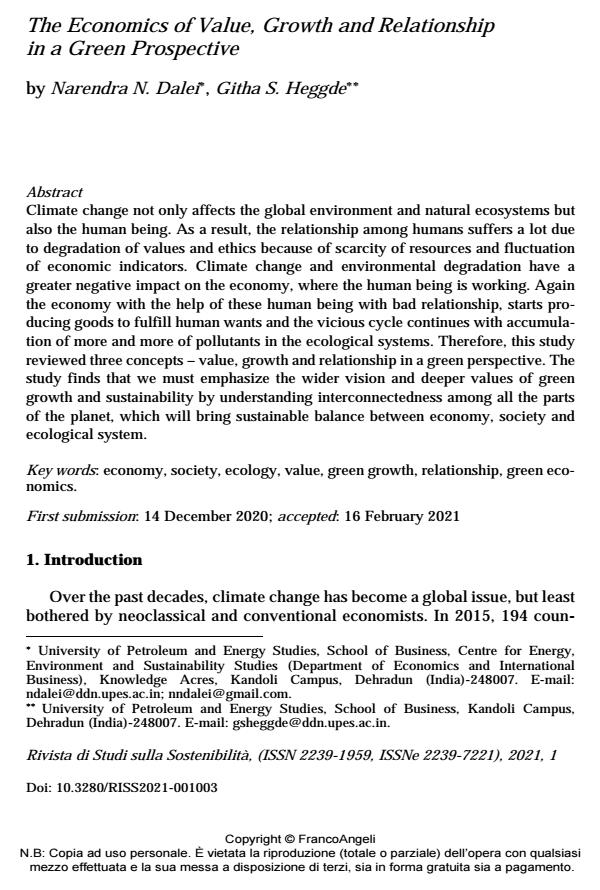The Economics of Value, Growth and Relationship in a Green Prospective
Titolo Rivista RIVISTA DI STUDI SULLA SOSTENIBILITA'
Autori/Curatori Narendra N. Dalei, Githa S. Heggde
Anno di pubblicazione 2021 Fascicolo 2021/1 Lingua Inglese
Numero pagine 13 P. 29-41 Dimensione file 86 KB
DOI 10.3280/RISS2021-001003
Il DOI è il codice a barre della proprietà intellettuale: per saperne di più
clicca qui
Qui sotto puoi vedere in anteprima la prima pagina di questo articolo.
Se questo articolo ti interessa, lo puoi acquistare (e scaricare in formato pdf) seguendo le facili indicazioni per acquistare il download credit. Acquista Download Credits per scaricare questo Articolo in formato PDF

FrancoAngeli è membro della Publishers International Linking Association, Inc (PILA)associazione indipendente e non profit per facilitare (attraverso i servizi tecnologici implementati da CrossRef.org) l’accesso degli studiosi ai contenuti digitali nelle pubblicazioni professionali e scientifiche
Climate change not only affects the global environment and natural ecosystems but also the human being. As a result, the relationship among humans suffers a lot due to degradation of values and ethics because of scarcity of resources and fluc-tuation of economic indicators. Climate change and environmental degradation have a greater negative impact on the economy, where the human being is work-ing. Again the economy with the help of these human being with bad relationship, starts producing goods to fulfill human wants and the vicious cycle continues with accumulation of more and more of pollutants in the ecological systems. Therefore, this study reviewed three concepts - value, growth and relationship in a green per-spective. The study finds that we must emphasize the wider vision and deeper val-ues of green growth and sustainability by understanding interconnectedness among all the parts of the planet, which will bring sustainable balance between economy, society and ecological system.
Keywords:Economy, society, ecology, value, green growth, relationship, green economics.
- Cato M.S. (2009). Green Economics. London EC1N 8XA, UK: Earthscan.
- Douthwaite R. (1992). The Growth Illusion: How Economic Growth Has Enriched the Few, Impoverished the Many and Endangered the Planet. Totnes: Green Books.
- Haldar S. (2019). Green entrepreneurship in theory and practice: insights from India. International Journal of Green Economics, 13(2): 99-119.
- Jänicke M. (2012). “Green growth”: From a growing eco-industry to economic sustainability. Energy Policy. 48. 13-21.
- Kennet M. (2007). Editorial: progress in Green Economics: ontology, concepts and philosophy. Civilisation and the lost factor of reality in social and environmental justice. Int. J. Green Economics, 1(3/4): 225-249.
- Kim S., Kim H. & Chae Y. (2014). A new approach to measuring green growth: Application to the OECD and Korea. Futures, 63. 37-48.
- Ling C.H.E.N. (2014). Ecological criticism based on social gender: The basic principles of Ecofeminism. Higher Education of Social Science, 7(1): 67-72.
- Lovelock J. (2000). Homage to Gaia: The Life of an Independent Scientist. Oxford: Oxford University Press.
- OECD (2007). Environmental Innovation and Global Markets, ENV/EPOC/ GSP(2007)2/REVI. X Paris: OECD.
- OECD (2019). Beyond Growth: Towards a New Economic Approach: Report of the Secretary General’s Advisory Group on a New Growth Narrative. SG/NAEC(2019)3. -- http://www.oecd.org/officialdocuments/publicdisplaydocumentpdf/?cote=SG/NAEC(2019)3&docLanguage=En.
- OECD (2017, 09 23). Green growth and sustainable development. -- Retrieved from OECD: http://www.oecd.org/greengrowth/.
- Okoh A.S. (2019). Green economy versus green economics: examining Africa’s conceptual uncertainty in the post-Paris era. International Journal of Green Economics, 13(1): 40-54.
- Olivier J., Maenhout G., Muntean M. & Peters J. (2016). Trends in global CO2 emissions: 2016 Report. Netherlands: PBL Publishers.
- Ou J.J.R. (2012). Construction of green competitiveness analysis index-a case study of export procession zone. International Journal of Electronic Business Management, 10(2): 140.
- Peter C. (2010). Cold climate in Copenhagen: China and the United States at COP15. Environmental Politics, 19(4): 637-656. DOI: 10.1080/09644016.2010.489718
- Porritt J. (2006). Capitalism as if the World Mattered. London: Earthscan.
- Sangwan K.S. (2011). Development of a multi criteria decision model for justification of green manufacturing systems. International Journal of Green Economics, 5(3): 285-305.
- Sonthi C., Harnphatananusorn S. & Santipolvut S. (2019). Concepts and empirical calculation of the green GDP for Thailand. International Journal of Green Economics, 13(1): 68-85.
- Stegemann L., Ossewaarde R. (2018). A sustainable myth: A neo-Gramscian perspective on the populist and post-truth tendencies of the European green growth discourse. Energy Research & Social Science.
- Sterner T. & Damon M. (2011). Green growth in the post-Copenhagen climate. Energy Policy, 39: 7165-7173.
- UNEP (2010). Green Economy Report: A Preview. New York. -- http://www.unep/greeneconomy/.
- Zein L.F. & Setiawan A. (2017). General Overview of Ecofeminism.
- Socio-economic development through self-help groups in rural India – a qualitative study Vinay Kandpal, in Qualitative Research in Financial Markets /2022 pp.621
DOI: 10.1108/QRFM-10-2021-0170
Narendra N. Dalei, Githa S. Heggde, The Economics of Value, Growth and Relationship in a Green Prospective in "RIVISTA DI STUDI SULLA SOSTENIBILITA'" 1/2021, pp 29-41, DOI: 10.3280/RISS2021-001003